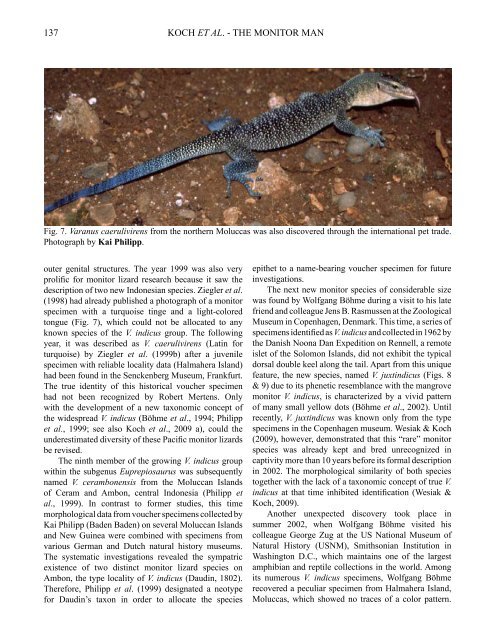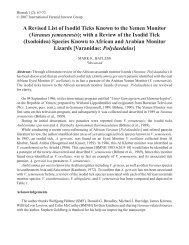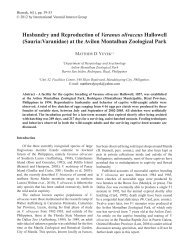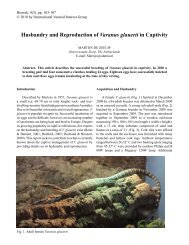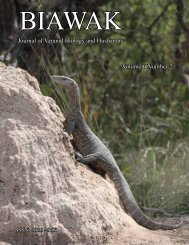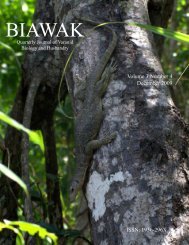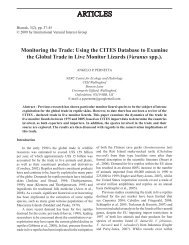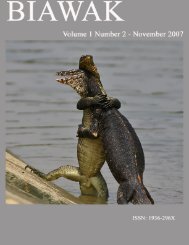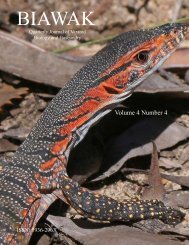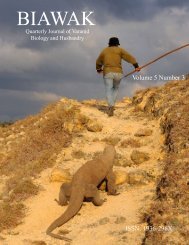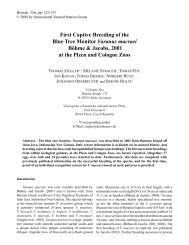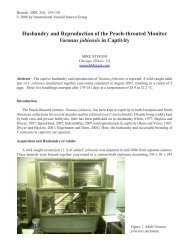BIAWAK - International Varanid Interest Group
BIAWAK - International Varanid Interest Group
BIAWAK - International Varanid Interest Group
- No tags were found...
You also want an ePaper? Increase the reach of your titles
YUMPU automatically turns print PDFs into web optimized ePapers that Google loves.
137<br />
KOCH ET AL. - THE MONITOR MAN<br />
Fig. 7. Varanus caerulivirens from the northern Moluccas was also discovered through the international pet trade.<br />
Photograph by Kai Philipp.<br />
outer genital structures. The year 1999 was also very<br />
prolific for monitor lizard research because it saw the<br />
description of two new Indonesian species. Ziegler et al.<br />
(1998) had already published a photograph of a monitor<br />
specimen with a turquoise tinge and a light-colored<br />
tongue (Fig. 7), which could not be allocated to any<br />
known species of the V. indicus group. The following<br />
year, it was described as V. caerulivirens (Latin for<br />
turquoise) by Ziegler et al. (1999b) after a juvenile<br />
specimen with reliable locality data (Halmahera Island)<br />
had been found in the Senckenberg Museum, Frankfurt.<br />
The true identity of this historical voucher specimen<br />
had not been recognized by Robert Mertens. Only<br />
with the development of a new taxonomic concept of<br />
the widespread V. indicus (Böhme et al., 1994; Philipp<br />
et al., 1999; see also Koch et al., 2009 a), could the<br />
underestimated diversity of these Pacific monitor lizards<br />
be revised.<br />
The ninth member of the growing V. indicus group<br />
within the subgenus Euprepiosaurus was subsequently<br />
named V. cerambonensis from the Moluccan Islands<br />
of Ceram and Ambon, central Indonesia (Philipp et<br />
al., 1999). In contrast to former studies, this time<br />
morphological data from voucher specimens collected by<br />
Kai Philipp (Baden Baden) on several Moluccan Islands<br />
and New Guinea were combined with specimens from<br />
various German and Dutch natural history museums.<br />
The systematic investigations revealed the sympatric<br />
existence of two distinct monitor lizard species on<br />
Ambon, the type locality of V. indicus (Daudin, 1802).<br />
Therefore, Philipp et al. (1999) designated a neotype<br />
for Daudin’s taxon in order to allocate the species<br />
epithet to a name-bearing voucher specimen for future<br />
investigations.<br />
The next new monitor species of considerable size<br />
was found by Wolfgang Böhme during a visit to his late<br />
friend and colleague Jens B. Rasmussen at the Zoological<br />
Museum in Copenhagen, Denmark. This time, a series of<br />
specimens identified as V. indicus and collected in 1962 by<br />
the Danish Noona Dan Expedition on Rennell, a remote<br />
islet of the Solomon Islands, did not exhibit the typical<br />
dorsal double keel along the tail. Apart from this unique<br />
feature, the new species, named V. juxtindicus (Figs. 8<br />
& 9) due to its phenetic resemblance with the mangrove<br />
monitor V. indicus, is characterized by a vivid pattern<br />
of many small yellow dots (Böhme et al., 2002). Until<br />
recently, V. juxtindicus was known only from the type<br />
specimens in the Copenhagen museum. Wesiak & Koch<br />
(2009), however, demonstrated that this “rare” monitor<br />
species was already kept and bred unrecognized in<br />
captivity more than 10 years before its formal description<br />
in 2002. The morphological similarity of both species<br />
together with the lack of a taxonomic concept of true V.<br />
indicus at that time inhibited identification (Wesiak &<br />
Koch, 2009).<br />
Another unexpected discovery took place in<br />
summer 2002, when Wolfgang Böhme visited his<br />
colleague George Zug at the US National Museum of<br />
Natural History (USNM), Smithsonian Institution in<br />
Washington D.C., which maintains one of the largest<br />
amphibian and reptile collections in the world. Among<br />
its numerous V. indicus specimens, Wolfgang Böhme<br />
recovered a peculiar specimen from Halmahera Island,<br />
Moluccas, which showed no traces of a color pattern.


